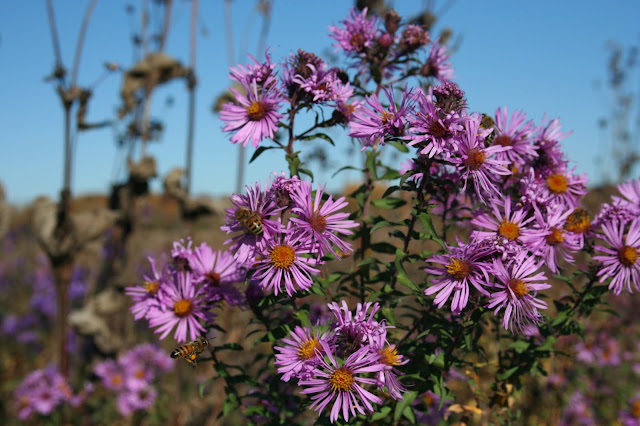New England Aster (Symphyotrichum novae-angliae) is a widespread native plant of open, low grasslands, meadows, roadsides and shore lands. Its stout, hairy stems grow 3-6 feet tall and branch at the top. Alternate, hairy leaves are up to 4 inches long and 1 inch wide. They clasp the stem at their bases.
Pink to purple flowers bloom from August into October at the ends of the stems. At 3/4 to 1-1/2 inches wide, the flowers are among the largest and showiest of the asters, and they can trick the eye. What looks like one flower is actually a group of florets in a head, called a head inflorescence. The center of the head bears small, tubular, yellow to orange disk florets. Around the disk are 50 or more pink or purple ray florets, so called because each bears a single, petal-like ray.
Below the head are green or greenish-purple bracts called phyllaries. The phyllaries of New England aster are narrow or lance-shaped with long points. They curve away from the head and are covered with short hairs. Some of the hairs are tipped with bulbous glands, appearing as tiny glistening dots under a magnifying lens. The stalk of each inflorescence, called a peduncle, is also hairy.
If you find New England Aster in bloom -- and if you have a steady hand and lots of patience -- pinch off a few disk flowers and use a needle to slit them open lengthwise. A 20x or higher magnifying lens will help. Inside the flower you may see that the filaments supporting the anthers are fused into a column that surrounds the style, the neck of the pistil. When the anthers open, they drop their pollen into the column. As the style elongates, its hairy surface picks up the pollen and makes it available to pollinators. The fused filaments of the stamens could explain the genus name Symphyotrichum, which means "joined hairs."
Many other asters in this region bloom at about the same time as New England Aster, but this species blooms later than most. Also, no other native aster has the same combination of large flower heads, clasping leaves, and hairy stems, leaves and phyllaries.
New England Aster is a late-season source of pollen and nectar for bees, moths and butterflies. To grow it in a garden or landscape, choose a location with moist to mesic, rich soil and full sun to partial shade. The plant will spread by rhizomes to form clumps. To maintain the plant's vigor in a garden, divide it in spring every three years.
References:
USDA Plants Database, https://plants.usda.gov/core/profile?symbol=SYNO2
Wetland Plants of Minnesota, by Steve W. Chadde. A Bogman Guide, 2012.
Pollinators of Native Plants, by Heather Holm. Pollination Press, LLC, 2014.





